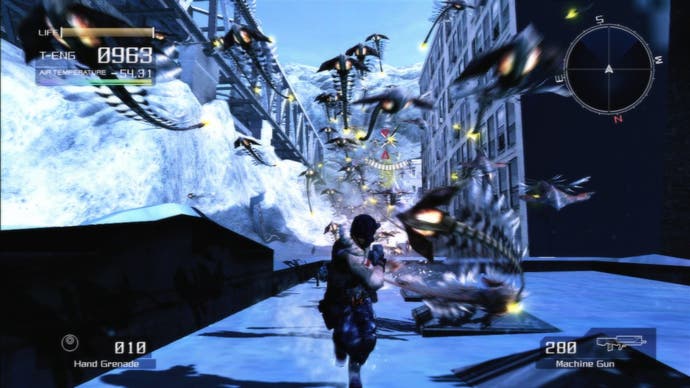Lost Planet: Extreme Condition
Hands-on with the first five levels.
Once upon a time, Earth was a bit rubbish. So we left. We got on spaceships, and flew off to a place called E.D.N. III. I don't know why it is called that - perhaps they had a competition, and that was a little girl's entry, and the little girl had some sort of horrible brain cancer and they couldn't say no despite the fact nobody was really keen on it.
Anyway, despite all the snow and the violent giant insects who killed lots of us, we decided to stick with the plan to colonise E.D.N. III. One reason for this was that the giant insects there released helpful blobs of orange when they perished. This "thermal energy" helped sustain us in the cold. And so we invented mechanical exoskeletons - or Vital Suits - in order to kill lots of insects and harvest their juice. The end.
That's roughly what happens in the boring cut-scene that sets the stage for Lost Planet, but things quickly improve. For instance, you're immediately being chased through an abandoned city by a gigantic beetle monster thing that smashes through skyscrapers in an attempt to spawn a glacier and drop it on your head.
Imagine the Bantha from Return of the Jedi but ten times bigger with the ability to spit massive rods of killer ice. This bit of the game's immediately brutal, giving you just enough room to stay ahead as you run down side streets glancing back over your shoulder in alarm, before climbing up a staircase and running along gangways that cut through the skyline, your eyes permanently fixed to the king of the cockroaches razing the city below you.
It concludes as you don your first Vital Suit, along with dad, and jump back to ground to face it. The "Green eye" it's called, and dad looks worried. As well he should be, because ten seconds later it belly-flops on his head.
Lost Planet, due out on 12th January, is sort of a bit like Halo meets Dune. On the one hand there are the things that lead you to draw up the Halo comparison - the unknown world with big secrets, mankind displaced and outnumbered, the two-gun weapon system, the rechargeable health bar, the fact that Keiji Inafune said it was his answer to Halo.

On the other there's the Dune element - factious bands fighting for control of sprawling, perilous and apparently lifeless terrain, and the idea of killing others for their lifeforce, and great concern over the wasting or casual dispensing of thermal energy. (That and it has giant desert worms in it, and Wayne looks a bit like Paul Atreides.)
But really it's not like Halo meets Dune, because it's more like Capcom meets Western shooter design. There's the immediacy and relentlessness (and the central preoccupation with guns) of the combat, and there's also the attempts to play in the same league as games like Half-Life with its giant set-pieces.
As well as the chase-level opener, a later mission sees you fighting your way to a mountaintop, with a giant flying monster playing various roles along the way - bombing you with explosive eggs as you fight through gullies full of insects with flowery heads that appear to have been routed through Day of the Triffids on their way from Starship Troopers; knocking you off your feet, as you emerge into the sunlight from a base cut into the mountain and it swoops past you like a banking airliner; and tackling you head on as you manoeuvre a Vital Suit into the basin on top of the mountain to conclude the battle.
The Vital Suits are obviously Japanese mecha in many senses, but they form only part of the combat. They're certainly essential to the boss fights, which generally occur at the end of each level, with their clunky movement offset by massive gatling guns, rocket launchers and lasers, but a healthy chunk of the action takes place on foot.

Here you move with the left analogue stick and turn with the right, but there are some Capcom-y sort of distinctions. For a start, twisting the right stick around doesn't immediately turn the camera, but actually moves your aiming reticule around a little invisible circle in the centre of the screen. When it reaches the boundary, it starts to tug the camera around with it.
To compensate for this obsession with the centre - presumably invented because the combat relies a lot on strafing side to side rather than addressing multiple targets from one position - you can also swivel 90 degrees at a touch of the left or right bumper, allowing you to follow the path of a passing enemy without needing to make a mess of the sensitivity settings.
Action sequences can be split into two main camps - snow pirate (human) and Akrid (insecty things). Snow pirates fight like men, with big guns and big numbers. Akrid are a bit more interesting - there are weird flying fish-skeleton style enemies that spiral towards you like biological missiles but shatter at the slightest brush of lead; there are armadillo-style creatures that form balls and roll at you and then need to be shot in the tail when they stop; there are spidery creatures whose egg sacs need to be targeted; and there are our Starship Triffid friends from earlier. The unifying element of these diverse creatures being their glowing orange thermal energy weak points.
It'll be interesting to see what other variations Capcom comes up with here - with the giant worms (which take a hell of a beating, but - judging by the available Achievements - can be slain) hinting at huge-scale encounters as well as tactical variety.


.png?width=291&height=164&fit=crop&quality=80&format=jpg&auto=webp)




.jpg?width=291&height=164&fit=crop&quality=80&format=jpg&auto=webp)
